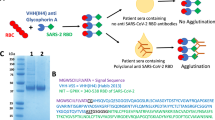Abstract
PORTERFIELD1 recommended the use of goose red blood cells for hæmagglutination and hæmagglu-tination inhibition (H.A.I.) tests with arborvirus antigens. Such tests are susceptible to non-specific inhibition by lipids present in normal animal serum2,3. These non-specific inhibitors are widely distributed4, but little is known of their nature or mode of action.
This is a preview of subscription content, access via your institution
Access options
Subscribe to this journal
Receive 51 print issues and online access
$199.00 per year
only $3.90 per issue
Buy this article
- Purchase on Springer Link
- Instant access to full article PDF
Prices may be subject to local taxes which are calculated during checkout
Similar content being viewed by others
References
Porterfield, J. S., Nature, 180, 1201 (1957).
Channock, R. M., and Sabin, A. B., J. Immunol., 73, 338 (1954).
Clarke, D. H., and Casals, J., Amer. J. Trop. Med. Hyg., 7, 561 (1958).
Salminen, A., Acta Virologica 4, 17 (1960).
Porterfield, J. S., and Rowe, C. E., Virology, 2, 765 (1960).
Williams, H., and Thorburn, H., J. Hyg. (Camb.), 59, 437 (1961).
Author information
Authors and Affiliations
Rights and permissions
About this article
Cite this article
WILLIAMS, H., THORBURN, H. Use of Goose Cells in Hæmagglutination Tests with Louping ill Virus Antigen. Nature 195, 520–521 (1962). https://doi.org/10.1038/195520b0
Issue Date:
DOI: https://doi.org/10.1038/195520b0
This article is cited by
-
A serological examination of Scottish strains of looping ill and their relation to other memhers of the complex
Archiv f�r die gesamte Virusforschung (1966)
Comments
By submitting a comment you agree to abide by our Terms and Community Guidelines. If you find something abusive or that does not comply with our terms or guidelines please flag it as inappropriate.



